|
| |||||||||||||||||||||||||||||||||||||||||||||||||||

| ||||||||||||||||||||||||||||||||||||||||||||||||||||
|
USENIX 2002 Annual Technical Conference Paper
[USENIX 2002 Technical Program Index]
Application-specific network management for energy-aware streaming of popular multimedia format
Abstract
The typical duration of multimedia streams makes wireless network
interface (WNIC) energy consumption a particularly acute problem
for mobile clients. In this work, we explore ways to transmit data
packets in a predictable fashion; allowing the clients to
transition the WNIC to a lower power consuming sleep
state. First, we show the limitations of IEEE 802.11 power saving
mode for isochronous multimedia streams. Without an understanding
of the stream requirements, they do not offer any energy savings
for multimedia streams over 56 kbps. The potential energy savings
is also affected by multiple clients sharing the same access
point. On the other hand, an application-specific server side
traffic shaping mechanism can offer good energy saving for all the
stream formats without any data loss. We show that the mechanism
can save up to 83% of the energy required for receiving data. The
technique offers similar savings for multiple clients sharing the
same wireless access point. For high fidelity streams, media
players react to these added delays by lowering the stream
fidelity. We propose that future media players should offer
configurable settings for recognizing such energy-aware packet
delay mechanisms.
1 Introduction
The proliferation of inexpensive, multimedia capable mobile devices
and ubiquitous high-speed network technologies to deliver multimedia
objects is fueling the demand for mobile streaming multimedia. Public
venues [31]
are deploying high speed IEEE 802.11b
[24] based public wireless
LAN networks. Commodity PDA devices that allow the users to consume
mobile streaming multimedia are becoming popular. A necessary feature
for mass acceptance of a streaming multimedia device is acceptable
battery life. Advances in hardware and software technologies have not
been matched by corresponding improvements in battery
technologies. Future trends in battery technologies alone (along with
the continual pressure for further device miniaturization) do not
promise dramatic improvements that will make this issue disappear.
Newer hardware improvements are reducing the power consumption of system components such as back-lit displays, CPUs etc. However, WNICs operating at the same frequency band and range continue to consume significant power. Earlier work by Stemm et al. [32] reported that the network interfaces draw significant amounts of power. For example, a 2.4 GHz Wavelan DSSS card (11 Mbps) consumes 177 mW while in sleep state, but consumes 1319 mW while idle. Havinga et al. [18] noted that this Wavelan card consumes 1425 mW for receiving data and 1675 mW for transmitting data. For comparison, a fully operational Compaq iPAQ PDA only consumes 929 mW while the same iPAQ consumes 470 mW with the backlight turned off [14, 8]. For reference, the iPAQ is equipped with two 2850 mWh batteries, one each in the unit and the PCMCIA sleeve. Streaming media tends to be large and long running and consume significant amounts of network resources to download data. Hence, it is important to look at techniques to reduce the energy consumed by the network interface to download the multimedia stream. Traditionally, reducing the fidelity of the stream and hence the size is a popular technique that is used to customize the multimedia stream for a low bandwidth network. Reducing multimedia fidelity can also be expected to reduce the amount of data and hence the total energy consumed. However, if care is not taken to return the network interface to the sleep state as much as possible, reducing the amount of transmitted data will have negligible effect on the overall client energy consumption. Frequent switching to low power consumption states also promises the added benefit of allowing the batteries to recover, exploiting the battery recovery effect [7]. In our earlier work [5], we explored the client WNIC energy implications of popular streaming formats (Microsoft media [28], Real media [29] and Quicktime [2]) under varying network conditions. We believe that these widely popular formats are more likely to be deployed than custom streaming formats (that are specially optimized for lower energy consumption). Based on our observations, we developed history based client-side techniques to exploit the stream behavior and lower the energy required to receive these streams. We illustrated the limitations of such client-side policies in predicting the next packet arrival times. These client-only policies do not allow us to achieve the potential energy saving for consuming multimedia streams without losing data packets. In general, mechanisms that make the data packets arrive at predictable intervals can facilitate such transitions to lower power states. The choice of these transmission periods is a trade-off between frequent transitions to high power states and added delays in the multimedia stream reception. Such traffic shaping can be realized either in the origin server, in the network infrastructure closer to the mobile client and in the access point itself; at the MAC level. In this work, we analyze the effectiveness of these different approaches in regulating the streams to transmit data packets at regular, predictable intervals. Such packet arrivals enable client-side mechanisms to effectively transition the wireless interfaces to a lower power consuming sleep state. In this work, we show the limitations of MAC level IEEE 802.11 power saving mode for isochronous multimedia streams. The access points have to balance potential energy savings for a single mobile client with a need for fair allocation of network resources. Without an understanding of the stream requirements, these MAC level mechanisms do not offer any energy savings for multimedia streams over 56 kbps. The potential energy savings also reduces for multiple clients sharing the same access point. On the other hand, a server side traffic shaping mechanism can offer good energy saving for all the stream formats without any data loss. We show that the mechanism can save up to 83% of the energy required for receiving useful data. The technique can also offer similar savings for multiple clients sharing the same wireless access point. For high fidelity streams, typical media systems react to these added delays by lowering the stream quality. We propose that future media players offer configurable settings for clients operating under energy conserving WLAN systems such that these delays are not associated with network congestion. The remainder of this paper is organized as follows: Section 2 reviews our previous work as the necessary background and places our work in context to other related work. Next we present the experimental setup, evaluation methodologies, measurement metrics and the workloads used in our study in Section 3. Section 4 analyzes the effectiveness of IEEE 802.11 power management scheme to conserve energy for our streams. Section 5 explores the effectiveness of server side assistance in conserving the WNIC energy on the client. We conclude in Section 6. 2 Related work
There has been considerable work on power management for components of
a mobile device. This work includes spindown policies for disks and
alternatives
[35,3,26,12,19],
scheduling policies for reducing CPU energy consumption
[34,17] and managing wireless communications
[20,11,21,30]. Our work is similar in
spirit to the work of Feeney et al. [15]. They obtain
detailed measurements of the energy consumption of an IEEE 802.11
wireless network interface operating in an ad hoc networking
environment. They showed that the energy consumption of an IEEE 802.11
wireless interface has a complex range of behavior and that the energy
consumption was not synonymous with bandwidth utilization. Our work
explores similar techniques for WNIC energy management for multimedia
traffic.
Lorch et al. [27] presented a survey of the various software techniques for energy management. Havinga et al. [18] presented an overview of techniques for energy management of multimedia streams. Agrawal et al. [1] described techniques for processing video data for transmission under low battery power conditions. Corner et al. [10] described the time scales of adaptation for mobile wireless video-conferencing systems. Ellis [13] advocates high level mechanisms for power management. Flinn et al. [16] demonstrated such a collaborative relationship between the operating system and application to meet user-specified goals for battery duration. Vahdat et al. [33] proposed that energy as a resource should be managed by the operating system. Kravets et al. [22] advocated an end-to-end model for conserving energy for wireless communications. In our earlier work [6], we utilized transcoding as an application level technique to reduce the image data; trading off image size for network transmission and storage costs. In this work, we explore high level mechanisms to enable the mobile client to transition to lower power states and reduce overall energy requirements. 2.1 Client-side history based adaptation mechanismIn our earlier work [5], we explored the energy implications of popular streaming formats (Microsoft media [28], Real media [29] and Quicktime [2]) under varying network conditions. We believe that these widely popular formats are more likely to be deployed than custom streaming formats (that are specially optimized for lower energy consumption). We showed that Microsoft media tended to transmit packets at regular intervals. For high bandwidth streams, Microsoft media exploits network level fragmentation, which can lead to excessive packet loss (and wasted energy) in a lossy network. Real stream packets tend to be sent closer to each other, especially at higher bandwidths. Quicktime packets sometimes arrive in quick succession; most likely an application level fragmentation mechanism.Based on our observations, we developed history based client-side techniques to exploit the stream behavior and lower the energy required to receive these streams. We illustrated the limitations of such client-side policies in predicting the next packet arrival times. We showed that the regularity of Microsoft media packet arrival rates allow simple, history based client-side policies to transition to lower power states with minimal data loss. A Microsoft media stream optimized for 28.8 Kbps can save over 80% in energy consumption with 2% data loss. A high bandwidth stream (768 Kbps) can still save 57% in energy consumption with less than 0.3% data loss. For comparison, the WNIC was only receiving data for 0.45% and 14.51% of the time for these two streams, respectively. Also, both Real and Quicktime packets were harder to predict at the client-side without understanding the semantics of the packets themselves. Quicktime's energy savings came at a high data loss, while Real offered negligible energy savings. We believe that modifying Real and Quicktime services to transmit larger data packets at regular intervals can offer better energy consumption characteristics with minimal latency and jitter. 2.2 MAC level power saving modesWireless technologies such as IEEE 802.11 [25,24] and Bluetooth [4] use a scheduled rendezvous mechanism of power saving wherein the wireless nodes switch to a low power sleep mode and periodically awaken to receive data from other nodes. Different wireless technologies utilize variations of this scheduled rendezvous mechanism. For example, IEEE 802.11 uses scheduled beacons along with a TIM/DTIM packet notification mechanism. Bluetooth, a wireless cable replacement technology, defines three different power saving modes; the sniff mode which defines a variable slave specific activity delay interval, the hold mode wherein the slave can sleep for a predetermined interval without participating in the data traffic and the park mode wherein the slave gives up its active member address. The potential energy saving progressively decreases from sniff to hold to park modes. In general, Bluetooth enabled devices with their range less than 10 meters consume less power than IEEE 802.11 based WLAN devices. For example, a typical Bluetooth device (Ericsson PBA 313 01/2) consumes 84 mW to receive data, 126 mW to transmit data while consuming as little as 2 mW in the park state. Energy consumption in a fully packaged system is likely to be higher. Bluetooth technology offers a vertically integrated solution with a lower data rate and range as compared to wireless LAN technologies. As such, Bluetooth technologies are tuned towards cable replacement rather than for isochronous traffic generated by multimedia traffic.3 System Architecture
In the last section we outlined earlier work on mechanisms for energy
efficient multimedia streaming as well as the limitations of
client-only policies in conserving energy without losing data packets.
In this section, we describe the objectives, the system architecture
and the experimental setup. We will highlight our experiences in the
next two sections.
3.1 ObjectivesOur primary goal was to reduce the energy required by the wireless client to consume a certain multimedia stream (of a given quality). We explore the effectiveness of energy aware traffic shaping in the network infrastructure closer to the mobile client and in the wireless access point itself. The mechanism should also allow energy savings for multiple wireless clients sharing the same wireless access point.Our experiments were designed to answer the following questions:
3.2 Architecture
The system architecture is illustrated in Figure 1. The system consists of a server side proxy (SSP) or local proxy (LP) and a client-side proxy (CSP). The server side proxy allows the flexibility of traffic shaping at the source, without actually modifying the multimedia servers themselves. The local proxy performs similar functionality to a server side proxy and shares the same LAN network with the wireless client. The server side and local proxies can inform the client-side proxy of the next scheduled data burst. The client-side proxy interacts with the server side or local proxies. It is the responsibility of the client-side proxy to transition the WNIC to a lower power sleep state between scheduled data transfers. Since no data transfers are expected during this sleep interval, no data is lost. 3.3 Experiment Setup
The system setup that was used to customize the network transmissions to conserve energy for popular streaming formats is illustrated in Figure 2. The various components of our system are:
The tcpdump packet traces captured by the Monitoring station were fed to our client-side proxy simulator to analyze the system energy performance without perturbing the Browser stations. We utilized published power parameters [32,18] for a 2.4 GHz DSSS IEEE 802.11b Orinoco card for our simulations. The model does not simulate lower level energy costs such as unsuccessful attempts to acquire the channel (media contention), or in messages lost due to collision, bit error or loss of wireless connectivity. Further, our simulations do not leverage the battery recovery effect. We assume a linear energy model for wireless NIC power consumption.
For our experiments, we used the Wall (movie) theatrical
trailer. We replayed the trailer from a DVD player and captured the
stream using the Dazzle Hollywood DV Bridge. We used Adobe
Premiere 6.0 to convert the captured DV stream to the various
streaming formats. The trailer was 1:59 minutes long.
The Wall trailer was digitized to a high quality stream and hence
allowed us the flexibility of creating streams of varying
formats and fidelities. Hence, we use this stream for the rest of
this paper.
| ||||||||||||||||||||||||||||||||||||||||||||||||||||||||||||||||||||||||||||||||||||||||||||||||||||||||||||||||||||||||||
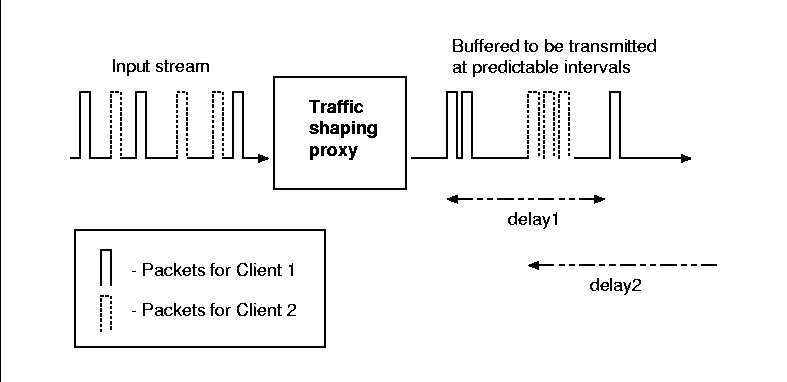
|
The various states of packet transmission for a traffic shaping network proxy is illustrated in Figure 3. The proxy buffers network packets from different flows (clients) and transmits them at client-specific intervals. The server maintains separate delay intervals per individual client (e.g. delay1 and delay2) and transmits packets to avoid contention on the wireless network. Such traffic shaping allows multiple clients to operate without interfering with each others' sleep intervals.
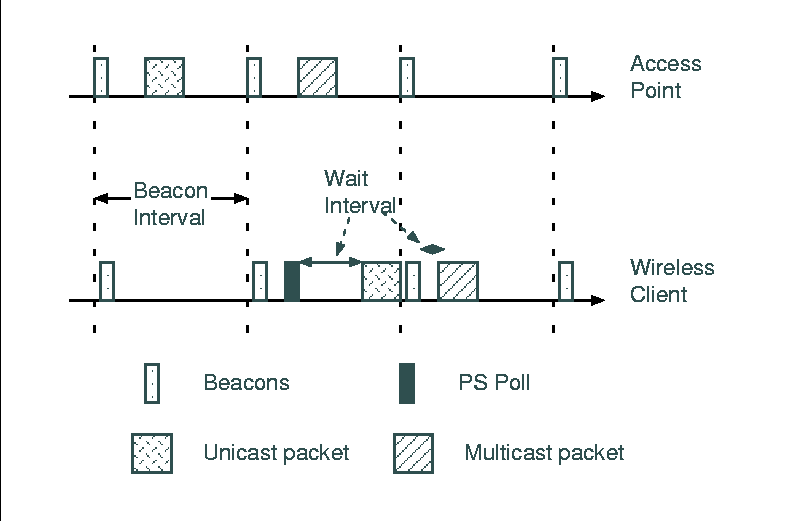
|
First we explore the effectiveness of IEEE 802.11 MAC level power saving mode for conserving the client WNIC energy consumption. In the next section, we investigate a proxy architecture to effect energy savings.
The IEEE 802.11 wireless LAN access standard [23] defines a power saving mode of operation wherein the wireless station and the access point cooperates to conserve energy (illustrated in Figure 4). The wireless station informs the access point of its intention to switch to power saving mode. Once in power saving mode, the wireless station switches the WNIC cards to a lower power sleep state; periodically waking up to receive beacons from the access point. The access point buffers any packets for this station and indicates a pending packet using a traffic indication map (TIM). These TIMs are included within beacons that are periodically transmitted from the access point. On receipt of an indication of a waiting packet at the access point, a wireless client sends a PS poll frame to the access point and waits for a response in the active (higher energy consuming) state. The access point responds to the poll by transmitting the pending packet or indication for future transmission. The access point indicates the availability of multiple buffered packets using the More data field. For multicast and broadcast packets, the access point transmits an indication for pending packets using a delivery TIM (DTIM) beacon frame; immediately followed by the actual multicast or broadcast packet (without an explicit PS poll from clients). DTIM intervals are usually configurable at the access point and can be any multiple of the beacon interval. The standard does not define the buffer management or aging policies in the access points. Note that the standard does not define a power saving transmit mode for the wireless station itself, it can transmit a packet whenever it wants (regardless of the beacon).
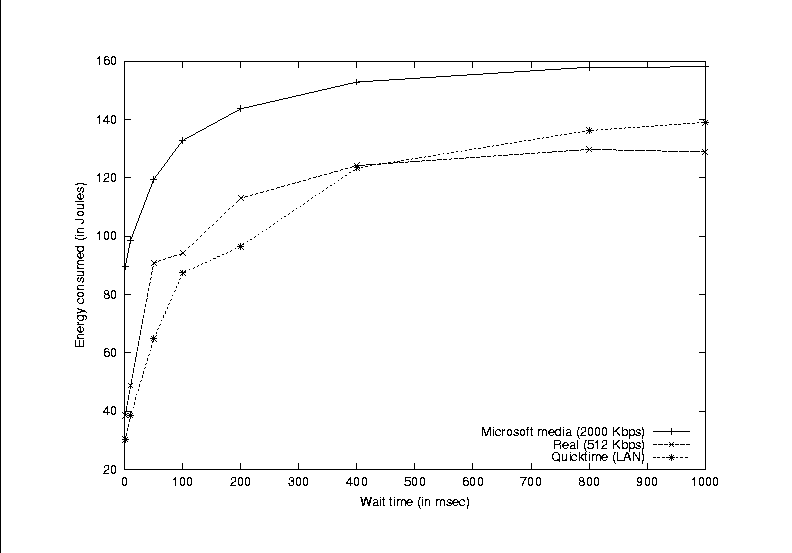
|
At first glance, it would appear that the 802.11 power saving mode can indeed allow the wireless clients to conserve energy by allowing them to frequently transition to lower power consuming sleep state. However, the potential energy saving depends on minimal Wait interval (time between the transmission of PS poll message and receipt of the data packet; illustrated in Figure 4). The IEEE 802.11 standard does not specify any time bound for this Wait interval. For a general purpose wireless access point, reducing the Wait interval has the inadvertent side effect of increasing the priority of data packets for wireless stations operating in the power saving mode. Access point manufacturers typically associate power saving mode as a lower throughput state. They also discourage high rate multicast traffic for the same reason.
In order to understand the implications of this wait interval, we developed a simple simulator that modeled the various power saving states of a popular WNIC. We modeled a 2.4 GHz Lucent wireless card that consumes 177 mW, 1319 mW and 1675 mW while in sleep, idle and read states, respectively. These energy parameters were published in [32,18]. We chose a beacon interval of 100 ms (used by Orinoco access points) and varied the average Wait times for reasonable values of 0 through 1000 msec. The access points are modeled with infinite buffer space; as the wait times increase, more packets are buffered and are sent back-to-back in succession. A realistic access point would drop these packets once the buffers fill up.
We plot the results for varying the average Wait interval for some of the streams measured in our earlier study ([5]) in Figure 5. For comparison, in [5], we noted that a client-side technique consumes 135 (0.15% data loss), 132 (8% data loss) and 47 (23% data loss) Joules for these MS Media, Apple Quicktime and Real streams, respectively. To receive these streams, the WNICs needed to be in active read state for 43.63%, 11.30% and 5.11% of the time, which corresponds to a necessary energy consumption of 90.24, 42.94 and 33.57 Joules, respectively. From Figure 5, we note that the potential energy saving is heavily dependent on the average Wait intervals. Wait times of zero illustrates the necessary energy consumption values. For average wait times less than 100 msec, even small increase in average Waits can drastically affect the energy saving. However, larger wait times do not offer much energy savings.
Hence, we tried to measure the actual Wait times for typical access points. We carefully disassembled the plastic shielding around a Orinoco Silver PC card and hooked two voltage probes around the two status LEDs. The first LED showed the card power state (transitioning to a high voltage stage while the card is active) while a second LED showed when a data packet was transmitted or received. We connected the PC card to an external Orinoco range extender antenna to reduce the effects of our instrumentation on the proper operation of the wireless card. We used this instrumented PC WNIC card on laptops running MS Win 2000, Win 98, Redhat Linux 7.2 and Compaq iPAQ; configured the PC card to operate in power saving mode and watched media streams using MS Media, Real and Apple Quicktime players for the Windows machines, Real for Linux and PocketTV and MS Media players for the iPAQ. For our study, we used Orinoco RG 1000, Orinoco AP 500 and D-Link DWL 1000 access points. All the access points were set up on a dedicated LAN segment (with no background network traffic) and operating on the same wireless channel.
We noticed that Orinoco RG 1000 and AP 500 access points used a beacon interval of 100 msec (in spite of our attempts at changing this interval; the Linux drivers provides an API to request a different beacon interval). The D-Link DWL 1000 allowed us to choose an interval of either 160 msec or 80 msec; the Windows driver did not allow us to modify this interval and chose 80 msec for TIM. We plot several representative results for the card status during our experiment in Figure 6. Note that the different plots show different parts of the video stream. We show the results for several low bitrate streams. These lower quality streams transmit less date and can be expected to offer considerable energy savings. In each graph, the plot for Channel 2 (top) shows the duration that the card stays in active state. Channel 1 (bottom) shows the duration when an actual packet is either transmitted or received at the card. Ideally, we want the top plot to be active for the least amount of time; appearing similar to the bottom plot.
Figure 6(a) plots the results for viewing a MS stream at 56 kbps using the iPAQ device. From Figure 6(a), we note that the power save mode sometimes works optimally. The first two data packets were received with the card in higher power state for the least amount of time. The third packet however triggers the card to stay in higher energy consuming state for a long time, the access point does not transmit the next packet until the next beacon interval (a Wait interval of 100 msec). Figure 6(b) plots the results for viewing a Apple Quicktime streaming at 30 kbps from a laptop. For Figure 6(b), we notice similar periods of active waiting. Also in Figure 6(c), we notice longer wait intervals for watching a Real stream at 56 kbps. As noted in [5], Real tends to spend many smaller packets (as compared to Microsoft media). Such packets tend to leave the WNIC at higher energy consuming active state while the access points tries to operate ``fairly'' for a general audience. In fact, we noticed that watching any stream over 56 kbps tends to completely leave the WNIC in higher energy consuming active state (even though it must be possible to keep the Wait times lower, albeit consuming most of the available bandwidth).
We also experimented with the power implications of receiving multimedia streams using multicast packets. The Orinoco drivers allow us to configure the DTIM interval (higher values would reduce the multicast throughput). We observed that even when the DTIM interval was the same as TIM interval, the access points tended to drop the multicast packets. In particular, the D-Link DWL 1000 access points dropped most of the multicast packets. Hence multicast was not a reliable streaming mechanism for our purposes.
In general, we believe that the 802.11b power saving mode has limitations for saving client WNIC energy consumption for the following reasons:
The mobile station can delay the transmission of the initial PS poll message to allow the access point to transmit data packets for other nodes. However, we are not aware of any such protocol defined by the standard to control the client PS poll interval.
| Stream Format | Stream b/w (in Kbps) | Energy (in Joules) | Client-side adaptation | |
|---|---|---|---|---|
| Energy (in Joules) | Bytes dropped (%) | |||
| Microsoft Media | 56 | 157.6 | 35 | 1 |
| 128 | 157.7 | 52 | 2 | |
| 256 | 160.2 | 60 | 0.5 | |
| 768 | 163.2 | 70 | 0.25 | |
| 2000 | 174.8 | 135 | 0.15 | |
| Real | 56 | 119.2 | 116 | 4 |
| 128 | 119.2 | 82 | 11 | |
| 256 | 124.3 | 120 | 5 | |
| 512 | 133.2 | 132 | 8 | |
| Quicktime | 56 | 149.7 | 41 | 30 |
| 128 | 150.1 | 38 | 38 | |
| 256 | 149.2 | 47 | 23 | |
In the last section, we discussed the limitations of utilizing the 802.11b MAC power management scheme for popular streaming media formats. In this section, we explore the implications of modifying the origin server (through a proxy) to customize the streams so that the clients can frequently transition the WNICs to lower energy consuming states.
In general, any traffic shaping at the origin server will be affected by the loss and delay characteristics of the wide-area Internet. Traditionally, buffering at the client had been used to offset these delays. However, the clients need to know the exact time of arrival for the first packet in order to minimize data loss. The loss of the last packet in a stream (which indicates the arrival of the next packet stream) affects the potential energy saving. Also, multiple clients using the same access point but receiving different streams would experience delays because of competing data reception characteristics. In summary, modifying the origin servers to shape the network traffic can enable clients to frequently transition to lower power states has the following drawbacks:
We implemented our policies on a local proxy based architecture. The local proxy buffers the multimedia packets and periodically transmits them to the client (similar in spirit to the IEEE 802.11 beacons). The local proxy could also dynamically inform the client-side of the next packet arrival time using a special control packet. The client-side proxy uses the interval between transmissions to transition the client WNIC to a lower energy consuming sleep state. The client-side proxy informs the local proxy server of the access point that it is associated with. The local proxy schedules the transmissions in such a way to avoid conflicts with other clients using the same wireless access point.
First we analyze the energy savings for the various popular streaming formats (MS Media, Real and Apple Quicktime) using streams customized for different network bandwidth requirements. We also explore the implications of multiple clients sharing the same wireless access point. For reference, the energy savings and the associated data loss for the various streaming formats using a client based adaptation strategy (that was discussed in [5]) is tabulated in Table 1.
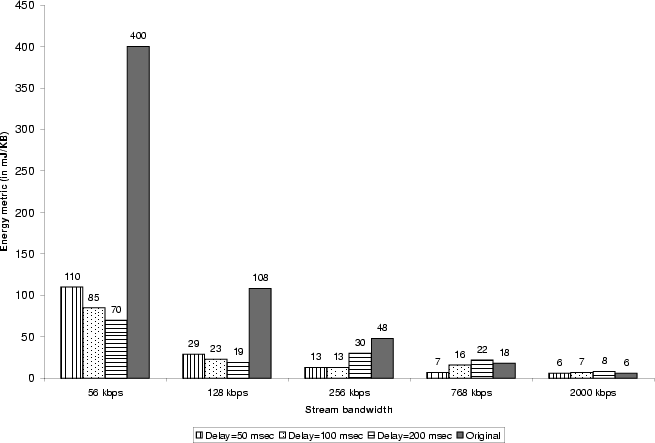
|
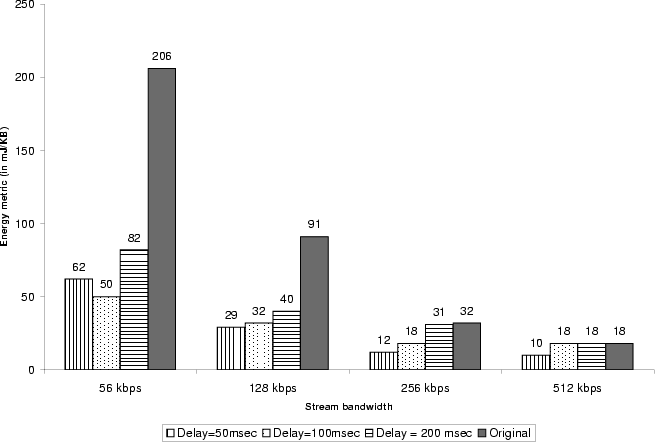
|
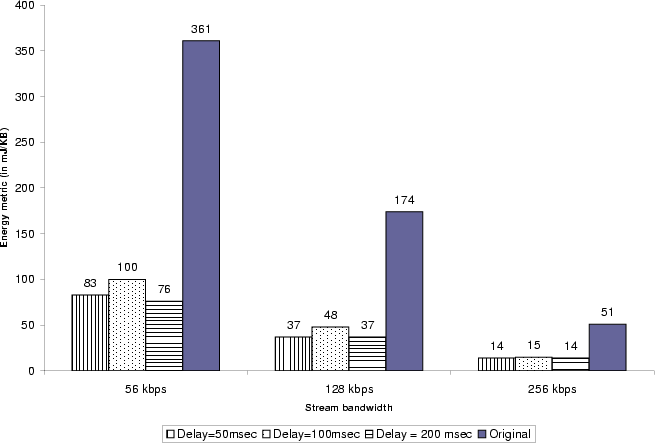
|
First we perform experiments to explore the energy saving possible with a cooperating proxy that enables the clients to transition to lower energy consuming sleep state. We explore the implications for popular streaming formats (Microsoft media, Real, Apple Quicktime). We configured the local proxy to transmit buffered packets after a delay of 50, 100 and 200 msec.
In some cases (e.g. high fidelity streams), depending on the delay introduced, the multimedia players automatically (and incorrectly) adapted to the delays by lowering the stream fidelity. In order to compare the energy consumption in such a scenario, we used the notion of energy metric, defined as the amount of energy required to download multimedia data (denoted in Joules/KB). It is preferable to reduce the energy metric.
We plot the energy metric for video streams customized for 56 kbps, 128 kbps, 256 kbps, 768 kbps and 2000 kbps bandwidth streams in Figure 7. From Figure 7, we note that a proxy that transmits packets every 200 msec can offer energy savings for low fidelity stream streams (without any data loss associated with a client-only scheme [5]). For a 56 kbps stream, a server that transmits packets every 200 msec can reduce the energy consumption by as much as 83%. However, for high bandwidth streams (low bandwidth streams are themselves transmitted infrequently) and increased delays, the media player adapts to increasing delays by reducing the stream fidelity. This results in reduced energy consumption while increasing the energy metric. In fact, the energy metric can sometimes be worse than (e.g. 768 kbps stream) receiving the original unmodified streams. Such adaptation can be counteracted by buffering the network packets in the client-side proxy and locally delivering them to the multimedia player at a more regular pace. Note that such additional buffering introduce their own energy requirements for maintaining the local buffers.
Also, we used the nanosleep() system call in the local proxy to delay packets for delivery. General purpose operating systems such as FreeBSD and Linux schedule sleeping jobs at 10 msec intervals and hence the actual sleep intervals can be at least 10 msec more than the programmed value. We noticed that this extra interval tends to be more than 10 msec for processes that sleep for longer intervals of time. The client-side proxy actively waits for packets in this extra 10 msec in a higher energy consuming idle state, leading to increased energy consumption and higher energy metric. Real time schedulers for Linux can reduce this scheduling interval to 2 msec. We are currently investigating such schedulers to further reduce the energy consumption.
| Stream Format | Stream b/w | Energy (in Joules) | Bytes dropped (%) |
|---|---|---|---|
| Microsoft Media | 56 Kbps | 37.00 | 0.79 |
| 128 Kbps | 54.03 | 0.09 | |
| 256 Kbps | 57.98 | 51.77 | |
| 768 Kbps | 72.74 | 19.77 | |
| 2000 Kbps | 135.34 | 10.17 | |
| Real | 56 Kbps | 39.63 | 39.10 |
| 128 Kbps | 58.23 | 24.74 | |
| 256 Kbps | 79.29 | 21.49 | |
| 512 Kbps | 96.35 | 34.42 | |
| Quicktime | 56 Kbps | 27.17 | 29.71 |
| 128 Kbps | 27.96 | 49.22 | |
| 256 Kbps | 32.94 | 41.49 |
In the last section we explored the potential energy savings for a simple server policy that transmits packets at predictable intervals (similar to the IEEE 802.11 MAC level power saving mode). We performed our experiments on a dedicated WLAN environment with a single wireless client. We showed that the potential energy savings over client-side policies. We discussed the effects of operating system scheduling policies that can reduce the potential energy saving. We also identified media player adaptation to increased packet delay and their effects on energy metric.
However, in a typical operating scenario, there could be many mobile clients within a single access point sharing the same physical medium. The local proxy with the knowledge of the physical WLAN limitation can schedule the clients such as to minimize data contention at the network. In this section, we explore the implications of two clients using the same wireless access point, consuming the same video stream (slightly offset in time to avoid the same data from being multicast just once).
First we tabulate the energy saving and the associated data loss for a client-side history based policy (described in [5]) in Table 2. Table 2 shows the inherent limitations of a client-side history based policies in a network with high contention. Both Real and Quicktime streams as well as high bandwidth Microsoft media streams experience higher data loss compared to a single client case shown in Table 1. Low bandwidth Microsoft media streams are transmitted at fairly regular intervals which are not affected much by the increased network contention.
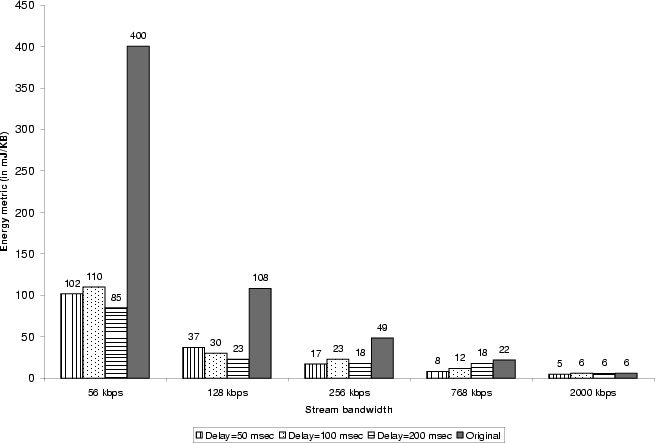
|
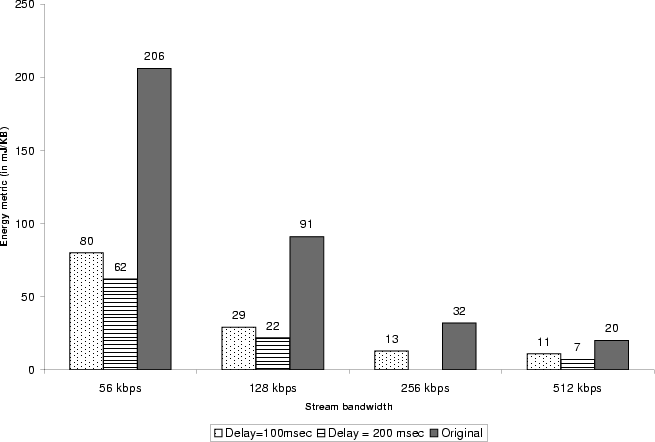
|
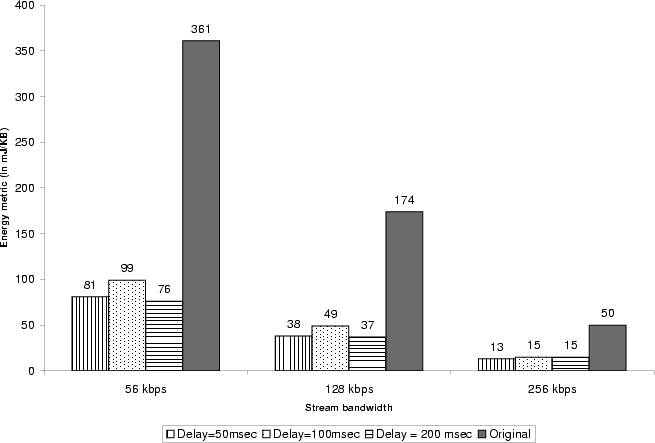
|
We repeated the experiments for Real streams and plot the results in Figure 11. For the most part, two clients provide similar savings as a single client case. However, Real players inexplicably experience fatal errors particularly operating with a delay of 50 msec. We are presently investigating why the Real players crash when two players are simultaneously accessing two multimedia streams.
In this section, we showed the effectiveness of application aware local proxy in shaping the multimedia traffic. The system can not only allow the clients to better manage their energy, but also schedule the packets to avoid local WLAN network contention. The Quicktime multimedia players adapt to any introduced delays by lowering the stream quality. A caching client-side proxy can help offset such client behavior.
On the other hand, an application-specific server side traffic shaping mechanism can offer good energy saving for all the stream formats without any data loss. We use a simple server enhancement to transmit network packets at predictable intervals. We show that we can reduce the energy metric (Joules/KB) by as much as 83%. We show how our approach can offer similar benefits for two clients sharing the same wireless access point. We note that the operating system scheduling mechanisms induce additional latencies that reduce further potential energy savings. Also, Quicktime players adapt to any network delays by lowering the stream quality.
Our work makes the following contributions towards the design of such application specific energy-aware network traffic shaping mechanisms:
|
This paper was originally published in the
Proceedings of the 2002 USENIX Annual Technical Conference, June 10-15, 2002, Monterey Conference Center, Monterey, California, USA.
Last changed: 16 May 2002 ml |
|